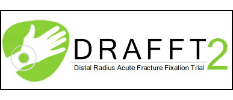For some background, we’re collecting data on registered-only patients in order to be able to place the results of the trial in the context of what actually happens in the treatment pathways across the country. This will let us understand who the patients are that are/aren’t being randomised, so that when the results are published we know who the results do/don’t apply to. We are expecting that across the trial a minority of patients will be registered-only, but this will vary depending on surgeons.
We would like all eligible patients to be approached, consented and registered – even those who will not be randomised because of an immediate surgeon preference for plate or k-wires. However, ideally we want surgeons to change how they approach the decision to plate/wire/cast and wait to decide whether a patient needs plate/wire/cast until after the manipulation has been done in theatre. If, after manipulation, the surgeon does have a strong preference for k-wires or cast then that’s no problem – the patient will have been registered and you can do baseline/6-week as normal.
Registrations as well as randomisations will be uploaded to CRN, with each patient uploaded once – so that sites get credit for registration-only and randomisation. We will also pay sites some amount for registered-only patients in addition to the current payments for randomised patients. Only numbers of randomised patients will be reported to REC and HTA.
1. I have been updating the site file and can’t find the amendment relating to the documents you have sent.
The baseline and 6 week CRF isn’t patient facing and does not require Ethics approval. The baseline CRF packs are staff-facing so approval isn’t needed. I’ve attached 3/6/12 months CRFs (which are patient-facing and approved) – we take care of following up patients at these time points so these are just FYI, not for use by sites.
2. Our patients have MUA under haematoma block in A&E and are seen n Fracture clinic at 1 week. Some will have displaced and need a further manipulation. Are these patients eligible for DRAFFT considering they have already had am MUA albeit in A&E? Or do they have to be ‘fresh’ and previously untreated?
If the surgeon decides that the patient would benefit from a manipulation in the operating theatre then they can still be enrolled after an MUA in ED – basically, the trial ignores what happens in ED and starts from the decision to offer surgical manipulation of the fracture
3. Could you please clarify what patient number needs to go on the Patient Questionnaire Pack, when they start the pack they have the 1st registration number (pre randomisation in surgery), and then continue post randomisation with their new patient number. It is not clear what patient ID number should be used.
Randomisation ID should be used once a patient is randomised and we are happy for both IDs to be present on all forms (can be added just above the dedicated ID field).
4. From our clinical director of orthopaedics. Some patients have an initial manipulation in A&E, are they still to be included?
Initial manipulation in the A&E doesn’t affect patient’s eligibility for the study: if the fracture requires further intervention- MUA and fixation, they can be assessed against eligibility criteria for the study and subsequently be included.
5. . Could we just clarify what patients you would like on the screening log, for May I have been putting patients who are not for surgery on the screening log, is this correct, or do you just require those who require MUA on the screening log?
If you could please continue to include patients without MUA that would be great – practice varies so much across hospitals that it’s really helpful for us to be able to tell what the differences in practice are. Patients who have a manipulation in A&E and do not require further manipulation should be on the screening log, but don’t need to be consented (unless they do end up requiring theatre manipulation within 2 weeks of injury).






